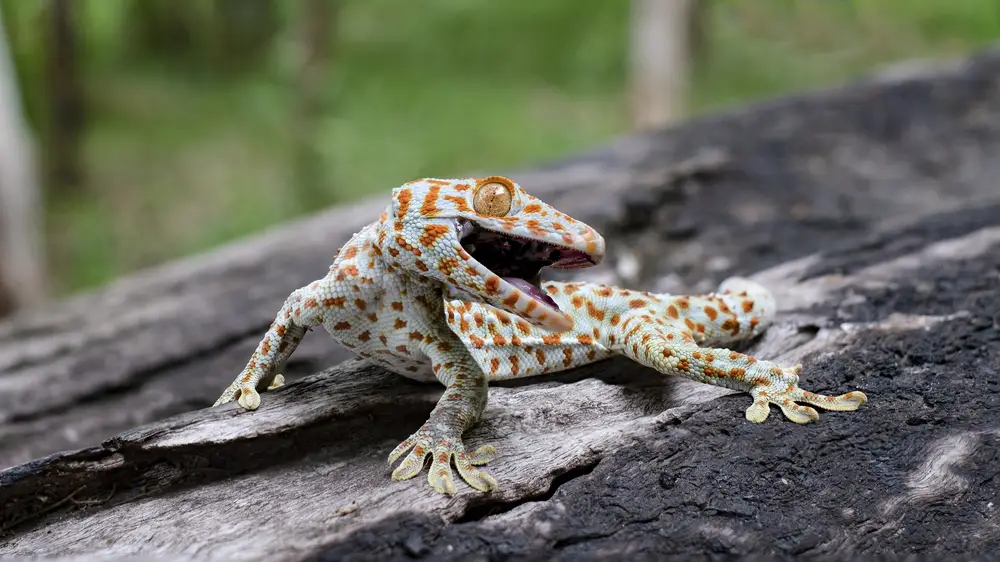Many people own geckos as pets, the most common being the Leopard or Crested Gecko. However, the Tokay Gecko isn’t as common but just as neat! So what about them? Do they make good pets? Are Tokay Geckos poisonous?
You need not worry, as the Tokay Gecko is not poisonous. But there are things you should be cautious of.
This article will discuss the Tokay Gecko and their care if they pose any danger. Read on to find out more about these vibrant-colored animals.
Are Tokay Geckos Poisonous?
No, Tokay geckos are not poisonous.
They are not even venomous.
Venomous animals inject their prey with toxins that can cause severe injury or even death, but Tokay geckos lack the mechanism to do this.
However, that doesn’t mean that they are harmless. Tokay geckos have sharp teeth and powerful jaws and can deliver a painful bite if they feel threatened.
They also have long tails that they can use to defend themselves from predators.
So while Tokay geckos may not be poisonous, they can still inflict some harm if provoked.
What are Tokay Geckos?
The Tokay Gecko, native to the rainforests of Asia, is the second largest gecko found on the planet. They are known for their beautiful colors and are often seen in blue-gray with orange and blue spots.
They aren’t recommended for beginners, but once you have established some experience, they are pretty easy to take care of.
What Do They Look Like?
Tokay Geckos are usually between 7 and 20 inches and weigh 150 and 400 grams. Their bodies are generally grayish blue with bright spots and a yellow or orange pupil. They have relatively large heads and large, round eyes, and they also have long, semi-prehensile tails.
Origins and Habitat
The Tokay Gecko comes from various parts of Asia, ranging from India, Bangladesh, and Nepal to Indonesia and New Guinea.
In the late 1980s, the species was brought to the United States and introduced in Florida and Hawaii, where they are now considered invasive.
In the wild, they usually remained on trees in the jungle, but as they became more popular, they adapted to human interaction.
Behavior
It’s not just their size that sets them apart from other geckos. The Tokay Geckos are nocturnal and live alone when not in mating season. Males, especially, can be aggressive and territorial and will defend their turf.
In captivity, geckos are often found on the ceilings and walls of their enclosure, looking for food. They aren’t overly fond of humans and can be aggressive if they feel threatened.
What do Tokay Geckos Eat?
In the wild, the Tokay eats different insects and invertebrates, with crickets and cockroaches being favorites. They will also eat smaller lizards and small vertebrates.
As pets, Tokay Geckos can be fed many things. They like mealworms, waxworms, crickets, or grasshoppers. They will even eat pinky mice. They may need extra calcium or vitamin supplements.
What is the Best Type of Enclosure for the Tokay Gecko?
An aquarium for the Tokay should be around 80 to 90 F during the day and a bit cooler, at 70 to 80 F, at night. Incandescent bulbs can be used for extra heat, and heating bulbs are preferred over heating pads as they can cause burns.
Like many reptiles, Tokay Geckos like a high humidity level, usually around 70 percent and not under 50 percent. Keeping the substrate damp with plenty of water in the enclosure will help to keep grades up.
Low levels of UV light are best for their health. Some people prefer a red bulb at night as it will allow you to see what your gecko is up to without disturbing their sleep cycle.
Other Interesting Facts About the Tokay Gecko
The Tokay Gecko is unique and has some great personality traits, including its sounds. Their mating call sounds more like a bark, saying, “To-Kay.”
They are also keen on adapting to their natural habitats in several ways.
- Their mouths are dark inside, while their lips are outlined in pink. When they open their mouths, they can make a hissing sound to make themselves appear scary. This is handy for predators that assume they are poisonous, even though they are not, as we’ve already learned.
- Their eyes are covered with protective lenses that come from transparent scales. If you see your Tokay licking their eyes, they are most likely cleaning them
- Tokay Geckos have mighty jaws and sharp teeth. This is what can cause a very nasty bite in either people or enemies
- The toes of the Tokay have ridges that have special toepads with lamellae on them. This allows them to move along any surface, including metal and glass. Pretty impressive!




